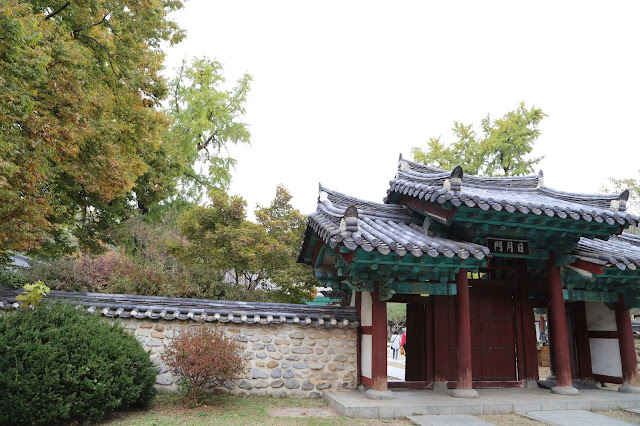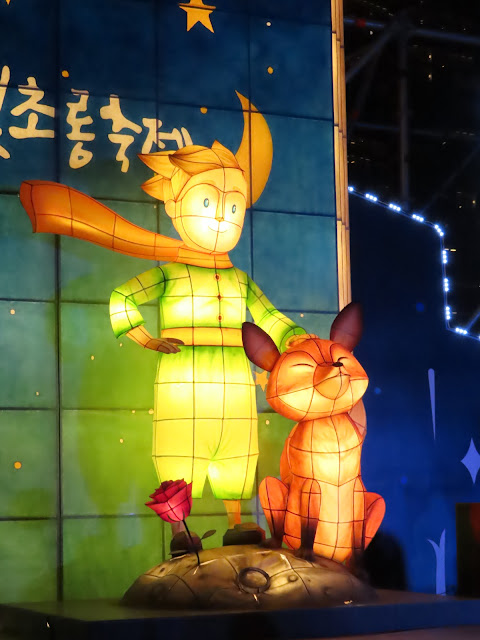We had a very tight itinerary planned for Day 3 of our
trip to South Korea, trying to see as much of Jeonju as we could in the morning before taking the KTX high-speed train to Seoul in the afternoon. Besides the famed Jeonju bibimbap (mixed rice), which we had tasted in our very
first dinner in Korea, the city is well known for its many ancient buildings and cultural heritage. With the large number of places of interest in the city, it would be a tall order to see them all in a morning. In the end, we made a selection covering both the Old and the New. In old Jeonju, we saw the
Jeonju Hyanggyo Confucian School (全州鄕校) and the landmark Jeonju Hanok (traditional Korean houses 韓屋) Village. In stark contrast was the jolly Jaman Mural Village with plenty of modern art work.

After checking out of our hotel rooms and leaving the luggage at the hotel reception, we started the day by looking for a place to have breakfast. On the way towards the old part of Jeonju where most tourist attractions are concentrated, we passed by a distinctive gate, of a style typically seen in Chinatowns in many cities across the world. It appears that not much of a local Chinese community now remains in Jeonju though. It is a bit funny that the inscription on the Gate reads 蘇州街 (or Suzhou Street), instead of say the name of the gate or some auspicious phrases, making it look like a giant and overly ornate street sign.
 |
| Gate marking the Jeonju Chinatown |
We opted for a Western style breakfast with toasted sandwiches, salad and coffee.
 |
| Western breakfast in Jeonju |
 |
| Decor of the cafe where we had breakfast |
After the nice breakfast, the first place we wanted to visit was the historical Jeonju Hyanggyo Confucian School (全州鄕校). Along the way, we noticed several stores displaying beautiful hanboks (traditional Korean clothing 韓服) for rent.
 |
| Elegant hanbok 韓服 for rent |
 |
| Hanbok 韓服 with delicate embroidery |
 |
| Interesting stall selling chimes |
 |
| Alley in old Jeonju |
 |
| Entrance of Jeonju Hyanggyo Confucian School, with signs in Chinese |
 |
Jeonju Hyanggyo Confucian School 全州鄕校
|
|
 |
Gate in Jeonju Hyanggyo Confucian School 全州鄕校
|
 |
| Shrine in Jeonju Hyanggyo Confucian School 全州鄕校 |
 |
| Wedding venue --- Jeonju Hyanggyo Confucian School |
 |
| Jeonju Hyanggyo Confucian School 全州鄕校 |
 |
| Wedding reception to be held on the school ground |
 |
| A very old tree standing the test of time |
 |
| Open air classroom |
 |
| Temple in Jeonju Hyanggyo Confucian School 全州鄕校 |
Adjacent to the Confucian School is the Jeonju Traditional Culture Training Center. We caught a glimpse of the activities there. We thought it was very impressive that a fairly large number of youngsters were willing to spend a Saturday morning at the Center learning traditional art and skills. On this morning, students dressed in full period attire practised ancient archery.
 |
| Learning traditional skills at the Jeonju Traditional Culture Training Center |
 |
| Jeonju Traditional Culture Training Center |
 |
| One of many Gingko trees 銀杏 in Jeonju |
 |
| Jeonju |
A more modern tourist attraction in Jeonju is the Jaman Mural Village, which provides plenty of photo ops or selfie spots. Below is just a small selection of the many colourful murals painted on the walls of the cluster of houses.
 |
| Cafe at the Jaman Mural Village |

 |
| Jeonju street fashion |
 |
| Golden yellow jingko 銀杏 |
Undisputedly, the most famous attraction in Jeonju is the Jeonju Hanok Village. Visiting the Village, walking through the narrow alleys between traditional houses, occasionally seeing tourists dressed in rented hanboks strolling along, was like taking a journey to the past.
 |
Distinctive hanok 韓屋 rooftops
|
 |
| Elegant hanbok 韓服 for rent |
 |
| Jeonju Hanok Village alley |
 |
| Jeonju Hanok Village alley |
 |
| Socializing under jingko trees in Jeonju Hanok Village |
After lunch in the Village, as we made our way back to the hotel, we ran into the Hanok Village Traditional Yunhee Parade. The band of locals carrying drums or other percussions were all dressed in costumes sporting the five colours of the traditional Korean colour spectrum (Obangsaek or five-orientation-colour 五方色) --- red, blue, yellow, white and black.
 |
| Hanok Village Traditional Yunhee Parade |
 |
| Making a joyful sound |
Near the Pungnammum Gate 豐南門, the historical south gate of the city fortress, we came across a Statue of Peace (or Comfort Woman Statue), which we had not noticed when we passed by this spot on the previous day. One of many placed in cities across South Korea, the statue is a sombre reminder of a dark moment in Korean history, and hopefully a warning against atrocities that should never be repeated.
 |
| Statue of Peace, Jeonju |
 |
| Statue of Peace, Jeonju |
We thought we had allowed ample time to pick up our luggage from the hotel and get to the train station to catch the pre-booked KTX train to Seoul. In reality, things didn't turn out as smoothly as we had planned. First, some unexpected drama unfolded with the taxi, which the hotel receptionist had ordered for us. After filling the boot with our luggage, the taxi driver refused to let us place the last suitcase in the passenger space. We watched in shock as the driver, in an unexplainable fit of fury, took all our luggage from the boot and literally threw everything on the pavement! Fortunately before the taxi drove off speedily, we noticed we had left on it a bag with passports and phone.
It was lucky that another taxi drove by soon after. This time, the driver allowed us to place the last suitcase on the lap of the passengers in the back seat. There was still plenty of time, we thought. But we had not anticipated the heavy traffic on a Saturday afternoon! Even with all the skills of the taxi driver, cutting lanes and forgoing all degrees of road manner, we barely got to the station with the thinnest margin of time before the scheduled departure of the train. Or rather, we got close enough to the station entrance and decided the only chance of catching the train was to run the last few hundred meters with our luggage rather than crawling on the taxi in the almost standstill traffic.
So it was a relief that we did manage to get on the train. The 1hr 45min journey gave us some time to calm down from the excitement of the un-intended rush.
We had chosen a hotel in the commercial and touristic Myeong-dong 明洞district, within walking distance from Seoul Station. The hotel was located on a small alley, and it was harder than we thought to get oriented and find the way there.
The hotel was quite close to the Cheonggyecheon Stream 清溪州 that runs through downtown Seoul. A lantern festival was being held on the Stream at the time. We were treated to a colourful display of a large collection of lanterns depicting characters in tradition Korean costumes as well as characters of Western origin. For a first-time visitor to South Korea, Seoul gave me an impression of a clean and tidy modern city, with a mixture of Korean and Western cultures. One could not fail to be impressed by the giant LED screens adorning many a building in downtown Seoul. The abundance of shops in Myeong-dong kept us occupied the whole evening after dinner.
 |
| Multi-cultural lanterns |
 |
| Seoul illuminated |
Previous:
Day 2 in South Korea

















































No comments:
Post a Comment